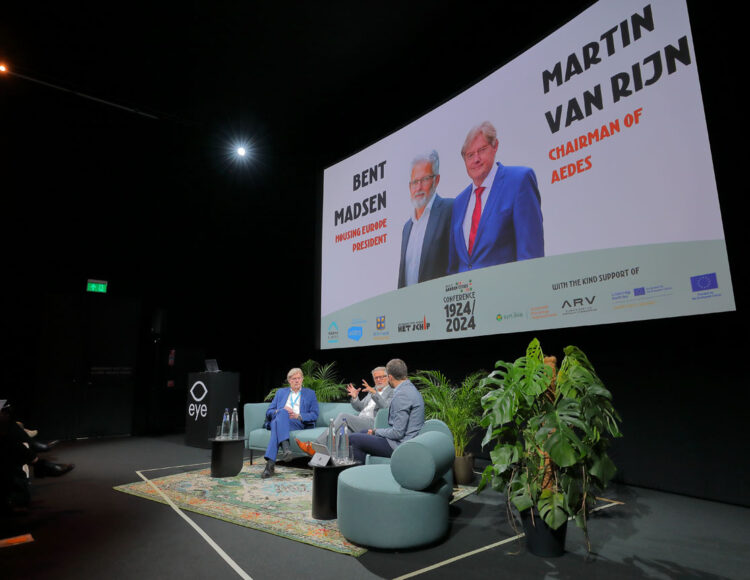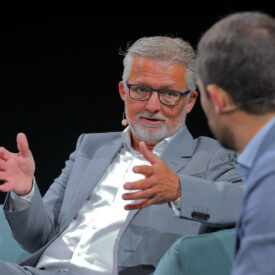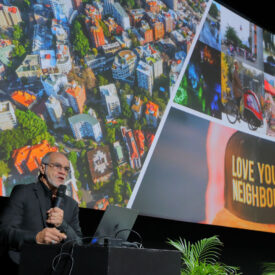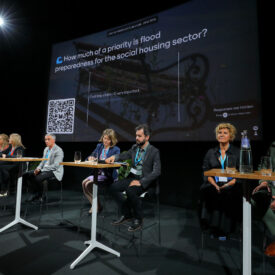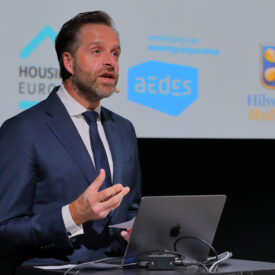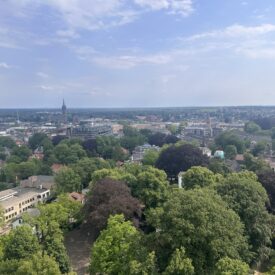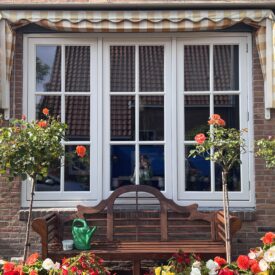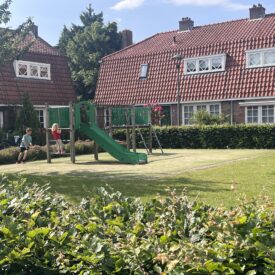While the voting for the new European Parliament was just starting in the Netherlands and the election campaign was often missing the answers to the core concerns of Europeans, Housing Europe focused on what matters.
At Housing Europe’s annual conference in Amsterdam – co-organised with Dutch social housing providers represented by AEDES, the City of Hilversum and Museum Het Schip, the intersection of climate adaptation, biodiversity, and the housing crisis took centre stage.
Our President, Bent Madsen emphasised the legacy of 1960s housing developments that prioritised nature, posing the question of how we can reinvigorate green spaces for active use today.
Carlos Moreno, the mind behind the 15-minute city concept, elaborated on the “happy proximity” – a vision where health, jobs, and sustainability converge to create beloved, intergenerational neighbourhoods. Discussions underscored the necessity of affordable, mixed-income housing as the cornerstone of livable cities. As Moreno reminded us, our urban choices over the next decade will shape our climate future, particularly impacting the most vulnerable populations.
The outgoing Dutch Housing Minister, Hugo de Jonge shared his wish that in the near future, tourists would associate the country not just with cyclists and fine artists but also with its social housing associations, where the principle of protecting people with solidarity is firmly anchored.
EU Commissioner for Jobs and Social Rights, Nicolas Schmit, joined us virtually and stressed the bursting housing crisis, as well as the complexity of balancing affordable housing with biodiversity in which our sector, he believes, can and should have a leading role.
Innovative solutions, such as Sustainable Plus Energy Neighbourhoods (SPEN) presented by the coordinator of the syn.ikia project, Niki Gaitani, offer a path forward.
We also marked on the ground 12m2 – the size of a parking lot – and rolled out different scenarios on how public, cooperative, and social housing providers can invest best to ensure that mobility for tenants is affordable, but also sustainable. This was made possible thanks to the EU-funded project, SHARE-North Squared.
Real-world challenges, such as flood preparedness, heat adaptation, biodiversity, and sufficiency, were brought to light
Lina Taddei of ACER, recounted the devastation of Ravenna’s floods and advocated for flood preparedness in social housing. Austrian member Gerlinde Gutheil and Dutch member Robin van Leijen shared insights on enhancing biodiversity and implementing sufficiency principles in urban development. With extreme heat becoming a global concern, the importance of heatproofing homes, as discussed by MatosinhosHabit, was clear.
Housing Europe’s Secretary General, Sorcha Edwards summed up the mission: to provide healthy homes, meet urgent housing needs, prepare for climate extremes, and preserve biodiversity. This is why we need to #VoteNewHousingParadigm.
The day before
The day before our annual conference, over 100 professionals committed to green, affordable homes gathered in Amsterdam for Day 1 of the World Garden Cities Conference, organised by the Amsterdam Museum, Het Schip.
Anne-Jo Visser, Director of the Amsterdam Federation of Housing Associations, posed a couple of crucial questions right at the start: how can we make the best out of green neighbourhoods while also facing the densification of big cities, how can we create socio-economically strong communities, and, of course, who will take on this challenge?
The Garden City movement, from its inception in the late 19th century to today, has had a profound impact on social housing and urban planning worldwide. Its ambassadors have shaped principles that promote affordable social housing, healthy green environments, and flourishing communities.
Katy Lock from the Town and Country Planning Association (TCPA) emphasised the need for strategic spatial approaches, substantial investment, and high standards supported by the government and local authorities. She warned that without these, the homes built by private players today could become “the slums of the future.”
Hilde Blank, CEO & partner at BVR, office for spatial design, highlighted that “those who work for governments and local authorities really need to get into the quality of homes (the hardware) but also the social side of them and who lives there (the software).”
Anne-Jo Visser also stressed: “the transformation will only be a success if we focus not just on the new buildings but also on the improvement of existing homes, and the people living there.”
Charlotte Griffioen, Director and Principal Architect at MVSA warmed us up for Housing Europe’s annual conference and the fact that we need to also think of different mobility and reducing car dependence. She highlighted that large-scale new developments in the Netherlands in the mid-range for instance do not have parking and rely on shared options.
After the conference, we split into two groups. One travelled to Housing Europe’s study visit in Utrecht, organised as part of the EU-funded ARV project, and the other, to experience firsthand how we can make the best out of modernist, post-war buildings today. The other group went off the beaten track and the touristy Dam centre to see for itself how do people live in the northern and western parts of the city.
Our afternoon in Utrecht
From Amsterdam, we left straight for the Overvecht Noord district in Utrecht to explore the legacy of modernist architecture in social housing. Organised by the municipality and Housing Europe, within the scope of our Horizon ARV project, this trip brought to the surface the challenges of renovating post-war housing estates.
Most social housing estates built in the 60-70s in Western Europe followed the lead to meet the great affordable housing demand that followed WWII. This often translated into massive concrete tower blocks surrounded by an abundance of open green space, which generated inward-looking, isolated housing estates with physical boundaries that segregated lower-income groups from the city. Eventually, modernist estates became a focal point of social exclusion and criminality.
Today, Overvecht Noord, built in the 1960s-1970s, aims to become fossil-free by 2030. Plans are in place to renovate 5,000 social housing units while improving public spaces and quality of life. This is why a peer-to-peer session also with the network of our Dutch member, AEDES was more than needed. We wanted to hear shared experiences and best practices for revitalising older housing estates with a focus on community involvement and green spaces.
Meantime in Amsterdam
We made it to Tuindorp Oostzaan to feel the spirit of Garden Villages in Amsterdam North. Sometimes almost coming out straight from a postcard, these homes built in the 20s remain predominantly social housing, preserving affordability and showcasing how community-focused planning can thrive.
Next, we went to what is called “New West Amsterdam” to delve into the post-war garden cities, where some of the first prefabricated buildings started popping up. Once threatened with demolition, these homes were saved by protests and are now protected, highlighting the community’s resilience and commitment to their heritage.
The neighbourhood with more than 170,000 people, the majority of which are from a different cultural background, however, is often stigmatised as problematic, or even “the worst in the Netherlands”. The Van Eesteren Museum is fighting the stigma – researching and showing the hidden stories of the people who created and continue to shape the area, such as the four female architects we heard of today.
Find some more photos from the two days below. They can easily look like a post card from small dreamy homes. In reality, they are Dutch social housing which might challenge quite a few misconceptions.
